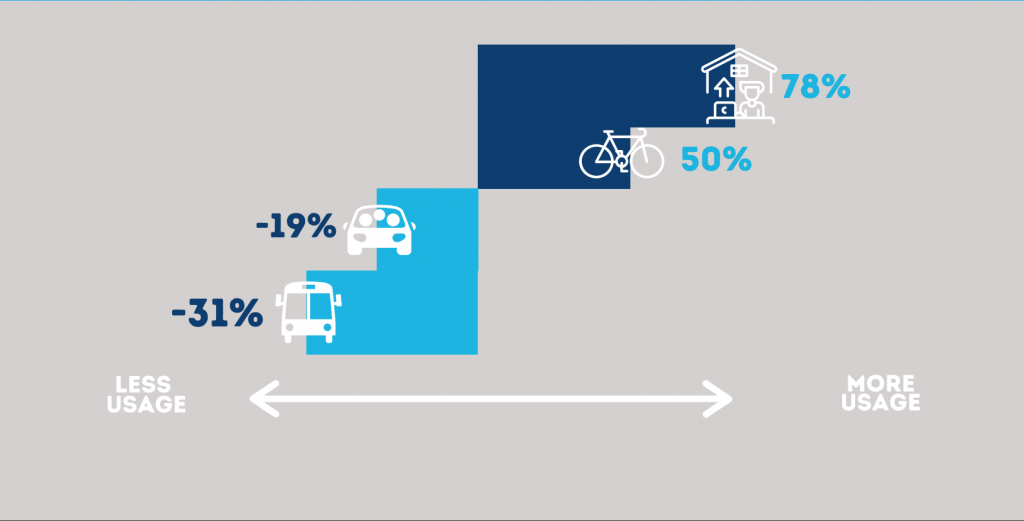By Kim Furtado
In early March 2020, I packed my bag with everything I would need to work from home for a few weeks. Little did I know, almost a year later, I would still be using my bedroom as my office (pictured above).
Working remotely has been a blessing and a challenge in many ways. As a young professional, I deeply miss the in-person network building and ability to pop into my boss’s office and ask a question or have a conversation. At the same time, reducing my carbon impacts with the immediate practice of telework, and the likely new telework schedule continuing (2 or 3 days a week) into the future, excites me.
I am not alone in enjoying certain aspects of teleworking. The Chittenden Area Transportation Management Association (CATMA) analyzed Vermont results from the Association for Commuter Transportation’s “COVID-19’s Impacts on Commuting” Survey. CATMA found that telework has risen 76% from its previous levels and 61% of Vermonters would like to continue teleworking in some capacity moving forward.

COVID-19 protection aside, countless sources profess the benefits of teleworking. There are the obvious benefits such as reduced employer costs (less office space, parking, utilities, etc.) and reduced environmental impact (fewer single occupancy vehicle commutes). Many also see increased employee morale and increased productivity. In addition, increased flexibility can be an asset for employers seeking to attract and maintain an employee-base of all ages by keeping older adults in the workforce longer (which is important for states like Vermont whose workforce is quickly aging) and giving those with younger family members the leeway often necessary for childcare.
Unfortunately, it’s not that simple. To reap the full benefits of teleworking, organizations will need to implement strong and fair policies surrounding telework and alternative flexible work options, or risk exacerbating existing inequities. Below, we explore some of the ways employers can step up.
Added costs
Although there are many benefits for those able to telework, many employees also face new costs as a result, such as setting up their workstations and paying increased electric and heating bills at home. Some states already require employers to reimburse their employees for all work-related expenses. Even without legal requirements, by reimbursing employees or providing a stipend for all equipment required to complete work, companies can take steps to ensure business can keep moving like a traditional office.
Workplace tensions
In addition to undue costs to those who are teleworking, individuals who have jobs where teleworking is not possible may face challenges of their own. One is simply an issue of fairness in the workplace: While many jobs offer the ability to work remotely, certain jobs require technology or in-person contact. When some employees do not have the option to work remotely but their colleagues do, tensions could disrupt the work environment. To offset this, employers should consider which types of flexible work options (e.g. flexible scheduling, compressed work weeks, etc.) are available for these employees. By offering flexible options to those with and those without the option to telework, employers can help ensure more equitable workplace environments for all.
Public transit challenges
The rise of teleworking during the pandemic has also exacerbated long-standing commuting inequalities and burdens, specifically for those who use public transit. Transit ridership is down nationwide. That is true in Vermont too (although, here it is more difficult to say how much of the lost ridership is from fewer riders or transit agencies’ policies which reduced bus capacity to 75%).

While the long-term impacts of reduced ridership are currently unknown, we do know that Vermonters most regularly riding public transit are in our lower income brackets and telework at a rate much lower than those in higher income brackets. If transit providers must cut services to balance their budgets, what options will bus-reliant folks have to get to their workplace safely? How will employers adapt and be flexible for these folks who don’t have the option to telework but may have less mobility options too?
To help alleviate some of the difficulties transit-dependent employees face, employers can work with their local transit provider to ensure there are routes accessible to and from their worksite, provide employees with free or discounted transit passes, or even advocate for their transit services to provide fare-free transit.
Making it work
There are so many unknowns for transportation in the future, but we know telework will continue to impact our commute behaviors in a variety of different ways. To reap the maximum benefits from teleworking and to mitigate negative associated effects – on both people and our transportation system – it is imperative that when employers institute telework policies, they are equitable for all employees. This means they work well and fairly for both those employees who can telework and those whose positions do not allow them to work remotely.
Both telework and transit are great ways to reduce the carbon impact of a business (and its employers), but to do this in a sustainable way, incentives and infrastructure must be equitable.
Learn more here about CATMA’s Telework Program, Tools and Resources. We will help you get there.
Kim Furtado is the Transportation Analyst at the Chittenden Area Transportation Management Association (CATMA). Her primary focus is managing CATMA’s extensive survey database and sharing data with CATMA members and the community. She hopes intentional data collection and transparent reporting can help bring forth sustainable and equitable transportation policy and habits.




